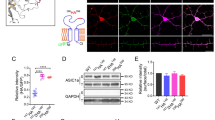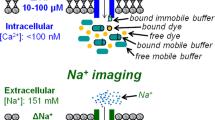Hippocalcin (HPCA) is a neuronal calcium sensor (NCS) protein that provides intracellular signaling via its Ca2+-dependent translocation from the cytosol to the plasma membrane. Although such translocation of HPCA and other NCS proteins is well established, no quantitative estimates of HPCA distribution between the cytosol and plasma membrane at the basal level of the intracellular free calcium concentration ([Ca2+]i) have been obtained. Thus, it is still unknown whether HPCA regulates its plasma membrane targets under resting conditions. In this work, we have evaluated this distribution in living cells at the basal level of [Ca2+]i, comparing HPCA spatial distribution with that of exogenously expressed membrane protein, EYFP-Mem. Using fluorescence recovery after photobleaching, we showed that the diffusion coefficient of fluorescently tagged HPCA in the dendrites of hippocampal neurons (~40 μm2/sec) is within the range of values typical of cytosolic proteins. The coefficient was about 10-fold higher than that for EYFP-Mem. Both results indicate that HPCA is mainly localized in the cytosol of the dendrites of hippocampal neurons. Next, direct calculations for HPCA fractions in the cytosol and plasma membrane at the basal level of [Ca2+]i demonstrated that the plasma membrane fraction of HPCA does not exceed 8%. Altogether, our results suggest that although being mainly cytosolic, HPCA may potentially signal its plasma membrane targets under resting conditions. New approaches used for obtaining such estimates can be applied for quantitative evaluation of NCS protein distribution in living cells under different experimental conditions and for the development of precise biophysical models of their signaling.
Similar content being viewed by others
References
R. D. Burgoyne, “Neuronal calcium sensor proteins: generating diversity in neuronal Ca2+ signalling,” Nat. Rev. Neurosci., 8, No. 3, 182–93 (2007); https://doi.org/10.1038/nrn2093.
R. D. Burgoyne, N. Helassa, H. V McCue, and L. P. Haynes, “Calcium sensors in neuronal function and dysfunction,” Cold Spring Harb. Perspect. Biol., 11, No. 5, a035154 (2019); https://doi.org/10.1101/cshperspect.a035154.
M. Ikura and J. B. Ames, “Genetic polymorphism and protein conformational plasticity in the calmodulin superfamily: two ways to promote multifunctionality,” Proc. Natl. Acad. Sci. U.S.A., 103, No. 5, 1159–1164 (2006); https://doi.org/10.1073/pnas.0508640103.
R. D. Burgoyne and L. P. Haynes, “Sense and specificity in neuronal calcium signalling,” Biochim. Biophys. Acta, 1853, No. 9, 1921–1932 (2015); https://doi.org/10.1016/j.bbamcr.2014.10.029.
G. Charlesworth, P. R. Angelova, F. Bartolomé-Robledo, et al., “Mutations in HPCA cause autosomal-recessive primary isolated dystonia,” Am. J. Hum. Genet., 96, 4, 657–665 (2015); https://doi.org/10.1016/j.ajhg.2015.02.007.
M. Kobayashi, T. Masaki, K. Hori, et al., “Hippocalcindeficient mice display a defect in cAMP response element-binding protein activation associated with impaired spatial and associative memory,” Neuroscience, 133, No. 2, 471–484 (2005); https://doi.org/10.1016/j.neuroscience.2005.02.034.
D. S. Osypenko, A. V. Dovgan, N. I. Kononenko, et al., “Perturbed Ca2+-dependent signaling of DYT2 hippocalcin mutant as mechanism of autosomal recessive dystonia,” Neurobiol. Dis., 132, 104529 (2019); https://doi.org/10.1016/j.nbd.2019.104529.
N. Helassa, S. V Antonyuk, L.-Y. Lian, et al., “Biophysical and functional characterization of hippocalcin mutants responsible for human dystonia,” Hum. Mol. Genet., 26, No. 13, 2426–2435 (2017); https://doi.org/10.1093/hmg/ddx133.
D. W. O’Callaghan, A. V Tepikin, and R. D. Burgoyne, “Dynamics and calcium sensitivity of the Ca2+/ myristoyl switch protein hippocalcin in living cells,” J. Cell Biol., 163, No. 4, 715–721 (2003); https://doi.org/10.1083/jcb.200306042.
J. B. Ames, R. Ishima, T. Tanaka, et al., “Molecular mechanics of calcium-myristoyl switches,” Nature, 389, No. 6647, 198–202 (1997); https://doi.org/10.1038/38310.
O. Markova, D. Fitzgerald, A. Stepanyuk, et al., “Hippocalcin signaling via site-specific translocation in hippocampal neurons,” Neurosci. Lett., 442, No. 2, 152–157 (2008); https://doi.org/10.1016/j.neulet.2008.06.089.
A. V. Dovgan, V. P. Cherkas, A R Stepanyuk, et al., “Decoding glutamate receptor activation by the Ca2+ sensor protein hippocalcin in rat hippocampal neurons,” Eur. J. Neurosci., 32, No. 3, 347–358 (2010); https://doi.org/10.1111/j.1460-9568.2010.07303.x.
A. V. Tzingounis, M. Kobayashi, K. Takamatsu, and R. A. Nicoll, “Hippocalcin gates the calcium activation of the slow afterhyperpolarization in hippocampal pyramidal cells,” Neuron, 53, No. 4, 487–493 (2007); https://doi.org/10.1016/j.neuron.2007.01.011.
C. L. Palmer, W. Lim, P. G. Hastie, et al., “Hippocalcin functions as a calcium sensor in hippocampal LTD,” Neuron, 47, No. 4, 487–494 (2005); https://doi.org/10.1016/j.neuron.2005.06.014.
M. Ormö, A. B. Cubitt, K. Kallio, et al., “Crystal structure of the Aequorea victoria green fluorescent protein,” Science, 273, No. 5280, 1392–1395 (1996); https://doi.org/10.1126/science.273.5280.1392.
D. W. O’Callaghan, L. Ivings, J. L. Weiss, et al., “Differential use of myristoyl groups on neuronal calcium sensor proteins as a determinant of spatio-temporal aspects of Ca2+ signal transduction,” J. Biol. Chem., 277, No. 16, 14227–14237 (2002); https://doi.org/10.1074/jbc.M111750200.
R. Swaminathan, C. P. Hoang, and A. S. Verkman, “Photobleaching recovery and anisotropy decay of green fluorescent protein GFP-S65T in solution and cells: Cytoplasmic viscosity probed by green fluorescent protein translational and rotational diffusion,” Biophys. J., 72, No. 4, 1900–1907 (1997); https://doi.org/10.1016/S0006-3495(97)78835-0.
M. Arrio-Dupont, G. Foucault, M. Vacher, et al., “Translational diffusion of globular proteins in the cytop-lasm of cultured muscle cells,” Biophys. J., 78, No. 2, 901–907 (2000); https://doi.org/10.1016/S0006-3495(00)76647-1.
S. Coscoy, F. Waharte, A. Gautreau, et al., “Molecular analysis of microscopic ezrin dynamics by two-photon FRAP,” Proc. Natl. Acad. Sci. U.S.A., 99, No. 20, 12813–12818 (2002); https://doi.org/10.1073/pnas.192084599.
D. Marguet, E. T. Spiliotis, T. Pentcheva, et al., “Lateral diffusion of GFP-tagged H2L(d) molecules and of GFPTAP1 reports on the assembly and retention of these molecules in the endoplasmic reticulum,” Immunity, 11, No. 2, 231–240 (1999); https://doi.org/10.1016/S1074-7613(00)80098-9.
J. Oyola-Cintrón, D. Caballero-Rivera, L. Ballester, et al., “Lateral diffusion, function, and expression of the slow channel congenital myasthenia syndrome αC418W nicotinic receptor mutation with changes in lipid raft components,” J. Biol. Chem., 290, No. 44, 26790–26800 (2015); https://doi.org/10.1074/jbc.M115.678573.
T. B. McAnaney, W. Zeng, C. F. Doe, et al., “Protonation, photobleaching, and photoactivation of yellow fluorescent protein (YFP 10C): A unifying mechanism,” Biochemistry, 44, No. 14, 5510–5524 (2005); https://doi.org/10.1021/bi047581f.
C. Spilker and K. H. Braunewell, “Calcium-myristoyl switch, subcellular localization, and calcium-dependent translocation of the neuronal calcium sensor protein VILIP-3, and comparison with VILIP-1 in hippocampal neurons,” Mol. Cell. Neurosci., 24, No. 3, 766–778 (2003), https://doi.org/10.1016/S1044-7431(03)00242-2.
Author information
Authors and Affiliations
Corresponding author
Rights and permissions
About this article
Cite this article
Sheremet, Y., Olifirov, B., Okhrimenko, A. et al. Hippocalcin Distribution between the Cytosol and Plasma Membrane of Living Cells. Neurophysiology 52, 2–13 (2020). https://doi.org/10.1007/s11062-020-09845-6
Received:
Published:
Issue Date:
DOI: https://doi.org/10.1007/s11062-020-09845-6




